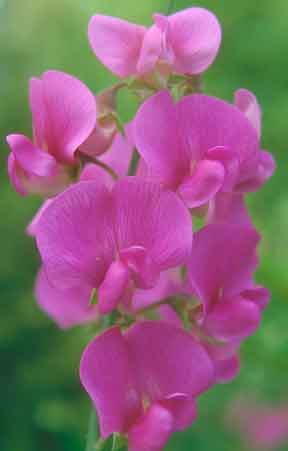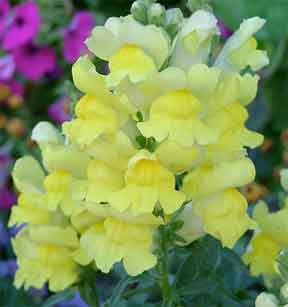After years of failure with old-time varieties of sweet peas, I am glad to say, based on several years’ experience, that we can grow these fragrant flowers in the Midwest.
For years, British seedsmen visiting us were amazed when we refused to get excited over their new varieties of sweet peas for growing out of doors. They just wouldn’t believe that our summers were too warm for them. Usually, they arrived here during the winter when the thermometer was hovering around zero and the wind was whipping across the bare ground.
To them, our conditions approached those found in Siberia, not the hot, dry country we tried to picture for them. If, however, they did come during the summer, they understood at once why their sweet pea varieties were not for us.

Decades ago, however, this picture changed. Frank Cuthbertson, one of the really great flower seed breeders of California, and himself brought up in the British tradition, with a love for sweet peas, decided to see what he could do about them.
By careful selection of varieties, he bred a heat resistant race that far surpassed older sorts in their ability to thrive at high temperatures. Later, other breeders produced varieties based on his foundation seed. Years later, Midwest gardeners got another break, when the Zvolanek varieties (with much longer spikes carrying more flowers to the stem) were combined with Cuthbertson blood. This latter strain, called Floribundas, was as fine as the best greenhouse varieties when well grown.
Today, using newer these varieties, home gardeners from the Appalachians to the Rockies, even as far south as Texas, can enjoy homegrown sweet peas in summer.
Extra Care Needed
True, if the thermometer goes above 90 degrees day after day, as it did in many parts of the Midwest even these tough vines may not be able to keep going. However, by sowing as early in spring as the soil can be worked, the gardener can produce a satisfactory crop by mid-July or early August which will more than pay for the effort required.
Here we must realize that there are few flowers which start flowering in late May or early June that will keep going until cut down by frost. I feel that if we get a month’s cutting from sweet pea vines, that is worthwhile. Many of the Cuthbertson and Floribunda varieties did better than that under conditions around Chicago.
To enjoy even a month’s season of sweet peas, we must be willing to give them more than casual care. This is true of any plant being grown under conditions which are generally unfavorable for its normal growth. We must substitute extra care for ideal conditions.
First requisite is soil. No member of the pea family likes wet feet, and sweet peas are no exception; If your soil is heavy clay and there is no chance to drain and lighten it with well-rotted organic matter or with vermiculite, better grow something else. The ideal soil is a loose, sandy loam with plenty of humus in it.
Next comes moisture. The vines should neither be drowned nor dried out. This means wetting the soil thoroughly, but stopping before all the pores are filled. Don’t wait until the vines wilt to water again, but repeat as soon as the soil just beneath the surface loses its wet look.
Mulches will help hold moisture in the our Midwest heat. Unfortunately, if kept soggy they may cause disease. Inorganic mulches such as vermiculite or perlite are better than organic materials. Peat moss is an exception, since it has rotted down to a point where it no longer will support fungus growth that causes disease. However, since it is acid, add a cupful of ground limestone to each bushel before using.
Don’t grow sweet peas on wires or wire netting in the Midwest; the metal gets so hot that the young tendrils will burn. Instead, train the vines on brush or string.
Sweet peas are legumes, which means that they need a special form of bacteria on the roots to do well. These are not disease organisms, but helpful bacteria that take nitrogen from the air and “fix” it so plants can use it for food. Most seedsmen sell special cultures of these bacteria, which can be mixed with seed before it is sown. The cost is practically nothing, and use of such a culture can make the difference between success and failure.
When to plant the seed is a problem. Fall planting (just before the ground freezes for the winter) is worth a gamble, even though in some parts of the area we are describing the seed may fail two years out of three. lf a fall planting does work, the vines grow more rapidly and flower sooner in spring. The result is a much longer flowering season.

Otherwise, sow the seed as early in spring as the soil can be worked. Some experienced gardeners farther south make a planting in mid-August, hop- ing the fall will be mild and give them late bloom. If the first planting in spring fails, it may not pay to reseed. However, since the seed is inexpensive, the gamble is worth taking but only if the Cuthbertson or Floribunda varieties are used.
A lot of nonsense has been uttered in the guise of information on depth of planting. Recommendations of as deep as 4 inches have been made. This just doesn’t make sense. The pea seed will grow best if planted not over 1/2 inch deep. Once the vines are up, earth can be thrown over the base of the vines (to keep them cool) but this can be overdone. If the stem is buried not more than 2 inches deep at the base, that should be enough. Deeper covering can smother the roots and kill the vines.
Sweet pea flowers must be kept cut. Once the pods have begun to form, the plant’s mission (to produce seed) has been served and the vine will die. Even if the flowers are not wanted for cutting, keep them removed.
Because sweet peas are no longer extensively planted, it is hard to find them in separate colors. Fortunately, all the colors are harmonious and can be mixed without producing ugly color combination’s. A good mixture of several varieties of sweet peas will give a wide range of color from pure white to deep maroon.
Fragrance is a tricky matter. In the dry, hot air of the Midwest, don’t expect too strong an odor. Best time to judge fragrance is early in the morning. The old Cuthbertson and Floribunda varieties were quite fragrant and a good mixture produced blooms that filled a room with their perfum e and there is no reason you cannot grow them today.
